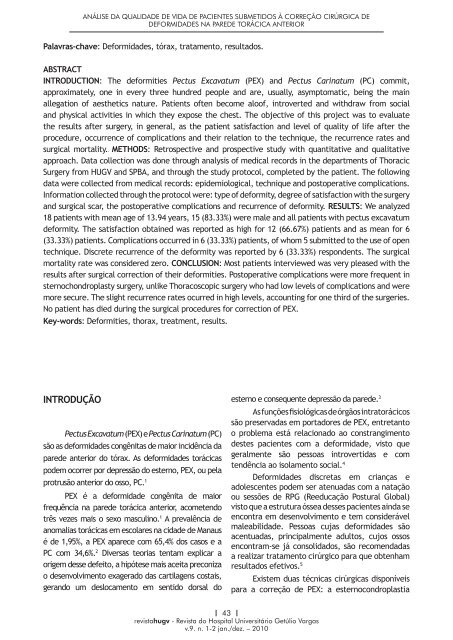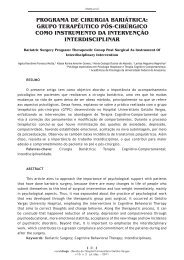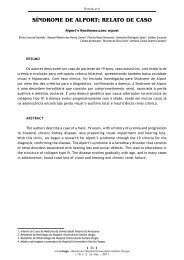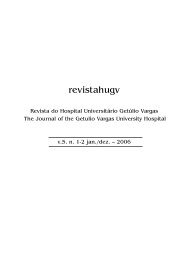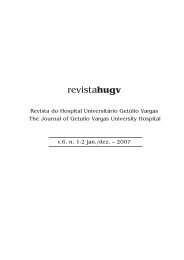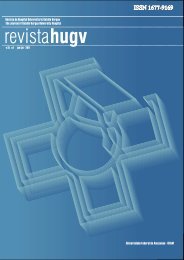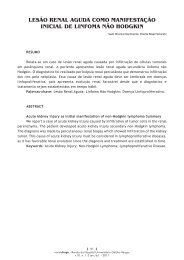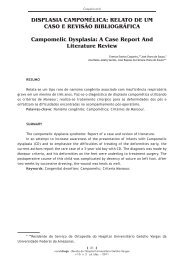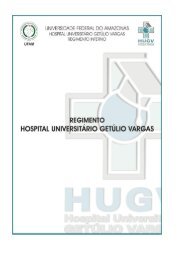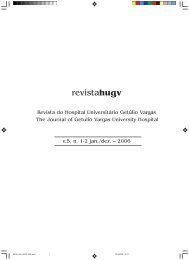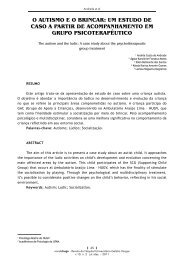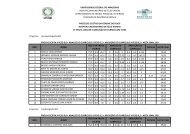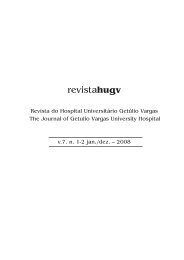Revista HUGV 2010 - Hospital Universitário Getúlio Vargas - Ufam
Revista HUGV 2010 - Hospital Universitário Getúlio Vargas - Ufam
Revista HUGV 2010 - Hospital Universitário Getúlio Vargas - Ufam
You also want an ePaper? Increase the reach of your titles
YUMPU automatically turns print PDFs into web optimized ePapers that Google loves.
ANÁLISE DA QUALIDADE DE VIDA DE PACIENTES SUBMETIDOS À CORREÇÃO CIRÚRGICA DE<br />
DEFORMIDADES NA PAREDE TORÁCICA ANTERIOR<br />
Palavras-chave: Deformidades, tórax, tratamento, resultados.<br />
ABSTRACT<br />
INTRODUCTION: The deformities Pectus Excavatum (PEX) and Pectus Carinatum (PC) commit,<br />
approximately, one in every three hundred people and are, usually, asymptomatic, being the main<br />
allegation of aesthetics nature. Patients often become aloof, introverted and withdraw from social<br />
and physical activities in which they expose the chest. The objective of this project was to evaluate<br />
the results after surgery, in general, as the patient satisfaction and level of quality of life after the<br />
procedure, occurrence of complications and their relation to the technique, the recurrence rates and<br />
surgical mortality. METHODS: Retrospective and prospective study with quantitative and qualitative<br />
approach. Data collection was done through analysis of medical records in the departments of Thoracic<br />
Surgery from <strong>HUGV</strong> and SPBA, and through the study protocol, completed by the patient. The following<br />
data were collected from medical records: epidemiological, technique and postoperative complications.<br />
Information collected through the protocol were: type of deformity, degree of satisfaction with the surgery<br />
and surgical scar, the postoperative complications and recurrence of deformity. RESULTS: We analyzed<br />
18 patients with mean age of 13.94 years, 15 (83.33%) were male and all patients with pectus excavatum<br />
deformity. The satisfaction obtained was reported as high for 12 (66.67%) patients and as mean for 6<br />
(33.33%) patients. Complications occurred in 6 (33.33%) patients, of whom 5 submitted to the use of open<br />
technique. Discrete recurrence of the deformity was reported by 6 (33.33%) respondents. The surgical<br />
mortality rate was considered zero. CONCLUSION: Most patients interviewed was very pleased with the<br />
results after surgical correction of their deformities. Postoperative complications were more frequent in<br />
sternochondroplasty surgery, unlike Thoracoscopic surgery who had low levels of complications and were<br />
more secure. The slight recurrence rates ocurred in high levels, accounting for one third of the surgeries.<br />
No patient has died during the surgical procedures for correction of PEX.<br />
Key-words: Deformities, thorax, treatment, results.<br />
INTRODUÇÃO<br />
Pectus Excavatum (PEX) e Pectus Carinatum (PC)<br />
são as deformidades congênitas de maior incidência da<br />
parede anterior do tórax. As deformidades torácicas<br />
podem ocorrer por depressão do esterno, PEX, ou pela<br />
protrusão anterior do osso, PC. 1<br />
PEX é a deformidade congênita de maior<br />
frequência na parede torácica anterior, acometendo<br />
três vezes mais o sexo masculino. 1 A prevalência de<br />
anomalias torácicas em escolares na cidade de Manaus<br />
é de 1,95%, a PEX aparece com 65,4% dos casos e a<br />
PC com 34,6%. 2 Diversas teorias tentam explicar a<br />
origem desse defeito, a hipótese mais aceita preconiza<br />
o desenvolvimento exagerado das cartilagens costais,<br />
gerando um deslocamento em sentido dorsal do<br />
esterno e consequente depressão da parede. 3<br />
As funções fisiológicas de órgãos intratorácicos<br />
são preservadas em portadores de PEX, entretanto<br />
o problema está relacionado ao constrangimento<br />
destes pacientes com a deformidade, visto que<br />
geralmente são pessoas introvertidas e com<br />
tendência ao isolamento social. 4<br />
Deformidades discretas em crianças e<br />
adolescentes podem ser atenuadas com a natação<br />
ou sessões de RPG (Reeducação Postural Global)<br />
visto que a estrutura óssea desses pacientes ainda se<br />
encontra em desenvolvimento e tem considerável<br />
maleabilidade. Pessoas cujas deformidades são<br />
acentuadas, principalmente adultos, cujos ossos<br />
encontram-se já consolidados, são recomendadas<br />
a realizar tratamento cirúrgico para que obtenham<br />
resultados efetivos. 5<br />
Existem duas técnicas cirúrgicas disponíveis<br />
para a correção de PEX: a esternocondroplastia<br />
43<br />
revistahugv - <strong>Revista</strong> do <strong>Hospital</strong> Universitário Getúlio <strong>Vargas</strong><br />
v.9. n. 1-2 jan./dez. – <strong>2010</strong>


